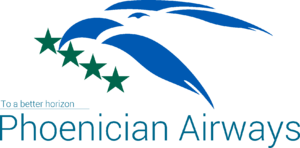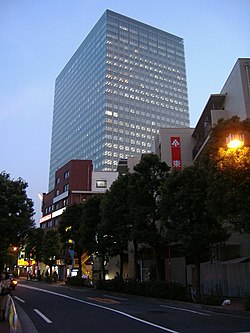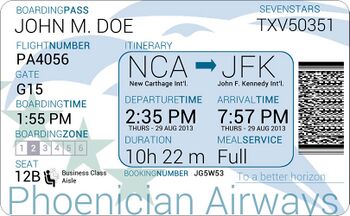Phoenician Airways
 | |||||||
| |||||||
| Founded | June 22, 1929 (as Carthage Air Lines) | ||||||
|---|---|---|---|---|---|---|---|
| Commenced operations | August 2, 1932 | ||||||
| AOC # | CTC-023/B | ||||||
| Hubs |
| ||||||
| Focus cities |
| ||||||
| Frequent-flyer program | Seven Stars | ||||||
| Alliance | GlobeStar | ||||||
| Subsidiaries | Subsidiaries List
| ||||||
| Fleet size | 2,064 | ||||||
| Destinations | 558 | ||||||
| Company slogan | "To a better horizon" | ||||||
| Parent company | Phoenician Holding Group, Ltd. | ||||||
| Headquarters | Carthage, Republic of Carthage | ||||||
| Key people |
| ||||||
| Revenue | |||||||
| Operating income | |||||||
| Net income | |||||||
| Total assets | |||||||
| Total equity | |||||||
| Employees | 143,000 (2016) | ||||||
| Website | FlyPhoenician.co.cth | ||||||
Phoenician Airways is a major domestic and international airline based in the Republic of Carthage, providing global service to Europe, Asia, and the Americas. Founded in June 1929 as Carthage Air Lines, it was acquired by the government in early 1932 and rechartered as Phoenician Airways to serve as the Republic's flag carrier. It served as the flag carrier of the republic until 1967, when it was privatized as part of an ongoing wave of airline deregulation. Since then, it has operated as the de facto flag carrier of Carthage, and one of the largest companies not affiliated with an existing conglomerate.
Based at New Carthage International Airport and operating over 19,000 flights daily with over 100,000 employees, the airline is the largest in Carthage by fleet size, revenue, and passenger volume and one of the founding members of the GlobeStar airline alliance. In 2015, Phoenician transported over 430 million scheduled passengers to more than 550 destinations. The current fleet size including subsidiaries exceeds 2,000 aircraft flying out of twelve major hubs with additional focus cities and secondary hubs.
History
Carthage Air Lines was founded on June 22, 1929 by Harper Rodes and Asdrúbal Barca in Theveste, Masaesyli as one of the first passenger airlines in Carthage. Passenger operations focused on the Capital Territory and the neighboring towns in Libya and Masaesyli until Carthage Air Lines received an airmail contract in 1930 to carry mail along the Carthage to Cartennae coastal route. The more lucrative mail contract prompted Carthage Air Lines to begin focusing more heavily on air mail contracts over passenger flights, steadily reducing the number of passenger seats over the next few years. The airline also tested a brief foray into crop dusting in 1931 as a means of diversification, but the steady revenue of the airmail contracts continued to dominate the airline's income.
In August 1931 the Carthaginian legislature passed the Air Transport Act, establishing a new set of rules governing the growing air travel industry in Carthage and laying out a plan to nationalize the air mail business while also developing a flag carrier as a means of developing international air travel links. The move toward government handling of the lucrative air mail routes prompted the owners of Carthage Air Lines to pursue a buyer for the airline and in April 1932, the government acquired Carthage Air Lines along with the assets of the recently-bankrupt United Air Mail Corporation and Patterson Transport. Carthage Air Lines's operating certificate and the assets of all three companies were used to establish Phoenician Airways, the official flag carrier of Carthage.
With government funding, Phoenician Airways began to focus on the passenger market once again, launching international routes to Europe, southern Africa, and Anatolia.
Corporate affairs
Organization and subsidiaries
Phoenician Airways is the principal subsidiary of Phoenician Holding Group, Ltd., the airline holding company responsible for managing Phoenician Airways and other related subsidiaries. Since Phoenician Airways was privatized in 1967, the Phoenician Holding Group has expanded into a number of related travel and leisure markets including hotels and travel booking, in addition to aircraft-related services such as catering, maintenance, and fuel contracting.
Commercial aviation
- RS Sky Catering, Inc. - The primary catering provider for Phoenician Airways and subsidiary flights, as well as several GlobeStar member flights operating out of Carthage.
- Phoenician Aviation Fuel Corporation - The fuel services provider at major Phoenician Airways hubs.
- Easy Skies, Inc. - A short-haul subsidiary airline aimed at the low-cost market.
- Phoenician Helicopter Services, Inc. - An operator of helicopter charter flights, including for national broadcaster Republic Broadcasting Service.
- Phoenician Cargo Airlines - A cargo airline operating dedicated freighter aircraft.
Travel services
- SevenStars Milage, Inc. - The management company for the SevenStars loyalty program.
- SevenStars Holdings, LLC - The management company for a variety of loyalty program-related services.
- Phoenician Hotels Group - The owner and operator of approximately 120 hotels across Carthage under the Quick Stay and Northern Reach brands, primarily located at airports.
- Phoenician Vacations, Inc. - A travel agency and tour operator.
Former
From 1972 to 2008, Phoenician Airways operated a regional carrier under the name Phoenician Regional and later Phoenician Express. This subsidiary used a mixture of its own fleet as well as independent carriers operating under the Phoenician Regional/Express brand to serve smaller destinations. In 2008, Phoenician Airways merged regional operations into its mainline fleet and began to phase out the use of independent carriers for regional flights.
Headquarters
Phoenician Airways is headquartered at Sky Plaza in the Tebourba district of Carthage. The office complex was completed in 2004 and is owned by Phoenician Airways, which is also the largest tenant. Other tenants include Icosium Financial and the Carthaginian headquarters of Mitsubishi. Prior to this, the corporate headquarters was located near the grounds of Carthage International Airport, near downtown Carthage. Following Phoenician Airways' departure of the complex, these offices were demolished and replaced with additional ramp space.
Hubs
Phoenician Airways operates ten domestic and four international hubs.
Domestic hubs
- Admiral Niklos International Airport (LNR2) – Admiral Niklos is Phoenician's largest hub and primary hub for Central Africa and the western Congo region. It also serves as the primary gateway to South America. Phoenician flies approximately 72 million passengers through LNR2 every year, or approximately 197,000 passengers per day. Phoenician accounts for approximately 65% of the annual passenger traffic at LNR2, making it the largest busiest airline at the airport. Phoenician currently controls Terminals 1 and 2 and is funding the construction of the new Terminal 6.
- Dakar International Airport (DKR1) – Dakar is Phoenician's second-largest hub and primary hub for West Africa. It also serves as the primary gateway for flights to the Caribbean and North America. Phoenician flies approximately 65 million passengers through DKR1 every year, or approximately 180,000 per day. This accounts for 74% of the passenger traffic and makes Phoenician the largest airline at the airport. Phoenician controls Terminals 5, 6, and 7.
- New Carthage International Airport (CTR2) – CTR2 is Phoenician's third-largest hub. It is the primary hub for North African flights and the primary gateway to Europe. Approximately 52 million passengers fly through CTR2 on Phoenician annually, or approximately 142,000 per day. Phoenician currently holds approximately 69% of the market share at New Carthage, making it the largest airline at the airport. Flights are primarily operated out of Terminals A and B as well as the International Terminal. Phoenician's corporate headquarters are also located in Carthage and its primary maintenance facility is located at CTR2.
- Ulysses S. Grant International Airport
- Khartoum International Airport
- Bujumbara International Airport
- Cairo International Airport
- Thomas Jefferson International Airport
- Arle Heinessen International Airport
- Paradisio Intercontinental Airport
International hubs
- Domodedovo International Airport
- Narita International Airport
- New York Factory International Airport
- Justinian I International Airport
Focus Cities
- Luanda International Airport
- Lilongwe International Airport
- Canti International Airport
- Vung Tao International Airport
Destinations
Phoenician operates flights to 364 domestic destinations and 194 international destinations in 94 countries across twelve continents.
Phoenician is a founding member of the GlobeStar alliance and has been a member continuously since 1996.
It has codeshare agreements with the following airlines:
- Air Brazil
- Air Frontier
- Air Jerusalem
- Arabian Air
- Babylon Air Lines
- Caribbean Air
- Golden Skies
- GoStar
- Imperial Japan Airlines
- Irkutsk Air
- Jordanian Airlines
- Manitoba Airways
- National Air
- Philippine Airlines
- Russian Imperial Airlines
- Thai Airways
- Washington Transport
- Western Airlines
Fleet
The Phoenician Airways fleet is composed primarily of Boeing and Cordoba Aerospace aircraft, although other manufacturers provide regional jets for short-haul flights. After reaching a peak average life of 14.5 years in 1995, additional capital investments in new aircraft have lowered the average age to 11.1 years, with older aircraft still being phased out. The fleet plans to phase out the last of its Boeing 767s within four years and replace them with newer 787 Dreamliner and TFV-300X aircraft, completing the transition to an all-widebody fleet for long- and medium-haul flights.
| Aircraft | In Service | Orders | Passengers | Haul | Notes | |||||
|---|---|---|---|---|---|---|---|---|---|---|
| S | F | B | E+ | E | Total | |||||
| Boeing 737-900ER | 321 | — | — | — | 20 | 42 | 117 | 179 | Short Haul | All aircraft being refitted to second configuration, expected to be completed by Q2 2018. |
| 39 | 120 | 179 | Refit model with Boeing Sky Interior and modernized furnishings. | |||||||
| Boeing 737 MAX 9 | 84 | 82 | — | — | 20 | 39 | 120 | 179 | Short Haul | First 60 units replaced smaller Boeing 737-800s inherited from Marquess Airways, additional orders for fleet expansion and replacement of older 737-900ERs. |
| Boeing 767-400ER | 54 | — | — | — | 40 | 62 | 142 | 244 | Medium Haul | Inherited from Marquess Airways, to be replaced by additional TFV-300X orders. Operated only on domestic flights. To be phased out by 2022. |
| 36 | 56 | 149 | 241 | |||||||
| Boeing 787-9 | 92 | 128 | — | — | 48 | 88 | 116 | 252 | Long Haul | International configuration, to be delivered through 2021. |
| — | 44 | 332 | 376 | Domestic 2-class configuration, replacing Boeing 777-200s. | ||||||
| Boeing 777-200 | 122 | — | — | — | 36 | 144 | 201 | 381 | Long Haul | Domestic 2-class configuration. To be retired by 2021, replaced by Boeing 787-9. |
| 24 | 156 | 212 | 392 | |||||||
| Boeing 777-300ER | 172 | 24 | — | — | 60 | 102 | 204 | 366 | Ultra-long Haul | Domestic 2-class configuration. |
| 8 | 42 | 104 | 124 | 278 | International 3-class configuration. | |||||
| Boeing 747-400 | 50 | — | — | 12 | 52 | 70 | 240 | 374 | Medium-Long Haul | To be retired by 2020, replaced by Cordoba TFV-400. |
| Cordoba TFV-220NE | 443 | 102 | — | — | 8 | 50 | 70 | 128 | Short Haul | |
| Cordoba TFV-300X | 192 | 62 | — | — | 40 | 62 | 148 | 250 | Medium-Long Haul | Additional orders expected to replace Boeing 767-400ERs. |
| — | — | 72 | 42 | 98 | 212 | Premium domestic configuration. | ||||
| Cordoba TFV-340NG | 294 | 44 | — | — | 50 | 72 | 148 | 270 | Long Haul | |
| — | 44 | 332 | 376 | High-density 2-class configuration. | ||||||
| Cordoba TFV-400α | 128 | 72 | 6 | — | 60 | 102 | 188 | 356 | Ultra-long Haul | Replacing Boeing 747-400s and international 777-200LRs. |
| Cordoba TFV-400β | 64 | 72 | 8 | — | 60 | 108 | 216 | 392 | Ultra-long Haul | International 3-class configuration. |
| — | — | 40 | 120 | 248 | 408 | Domestic 2-class configuration. | ||||
| Total | 2,016 | 586 | ||||||||

